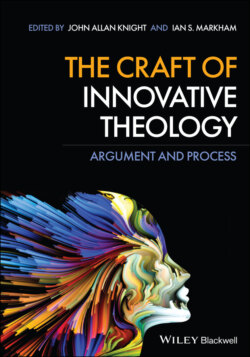Читать книгу The Craft of Innovative Theology - Группа авторов - Страница 10
Research Levels
ОглавлениеWe deliberately wanted a book that embraced a full spectrum of research writing, from the very accessible to the very difficult. To give the reader a sense of the level, each chapter has a ranking. Level 1 means that the article is accessible and teaches basic research skills. Level 2 means that the article has certain concepts that will require explanation, but a good student can grasp the issues. Level 3 means that the article assumes some knowledge of the field and, without such literacy, the argument will be difficult to grasp. One assumption we are making here is that reading articles that are technically beyond the reader actually helps the reader to grow. With the help of the glossary (all words in bold in the text are explained in the glossary at the end of the book) and with the sheer discipline of reading to the end, the reader will learn how to read at such a technical level. Level 4 means that there is a level of technical understanding and background knowledge that is essential for understanding the article. In the end, research articles are an act of participation in a pre‐existing conversation. To have credibility, one must know the existing participants in the conversation. The essays included in this book exhibit this kind of credibility and exemplify the ultimate goal of great innovative academic writing.
We have four articles at each ranking. At the first research level, Ian Markham offers an essay in Christology that argues that Jesus (the first‐century Jewish male) could have been Eternal Word made flesh in a different human form; he takes as his case study a person with Down’s Syndrome and argues that the Eternal Wisdom could have been made manifest in such a life. Also at this level, there is Pamela Jones offering a historical survey of the Southern Baptist Convention (SBC) and its journey to overcome the stigma of racism; she suggests that shifting attitudes in the SBC are partly linked to declining membership. Ian Markham has a second article at this level, in which he explores AI. He argues that it is possible that the church might have to face the emergence of “self‐conscious” AI entities that then should be granted human rights. And finally Thomas Oord’s chapter “Rentless Love and the Afterlife” argues that God would not compel a person to be either in heaven or hell. God’s character is unchangeable and that character does not compel.
At the second level, the book starts with Tinu Ruparell exploring the implications for theology of religious pluralism. He makes the case that all theology must take interreligious conversations seriously. Trevor Bechtel takes a serious look at the eating of animals; he argues that factory farming is deeply wrong and that no animal should be eaten that has not had a good life. Kathryn Blanchard looks at the debate in the US over COVID‐19 – health or business. She argues for a vision of business that takes seriously the full range of stakeholders. The last chapter at this level is written by Keith Ward; his essay argues that Christians should treat the language about the return of Christ in the same way as the creation narrative. To harmonize with the scientific narrative, we need to recognize that the language is not descriptive of the return of the resurrected Christ to Earth, but instead an affirmation that ultimately God’s providential plans for creation will be realized.
At the third level, we have two chapters on science and religion. Celia Deane‐Drummond reflects on what it means to be distinctively human. She advocates for getting away from “Image of God” language and instead drawing on Christology. Christopher Southgate argues that although evolution is true, it does create real problems for theology. His suggested solution is a compound theodicy. Andrei Buckareff looks at hell, suggesting that persons in hell will not necessarily be “unhappy” and that there is always an option to escape. Finally, in this third level, Martyn Percy invites the reader to see how all faith is conditioned in different ways by the culture in which it grows.
At the fourth level, we have Leigh Vicens who provides a nuanced account of the concept of responsibility. Given that no human can avoid sinning, in what sense should we be held responsible? Demonstrating mastery of the literature, she sees blame as a moral protest concept; it is not so much the person that is blamed but the actions that we do. The other level four essays are all in Part VI. John Knight teases out some linguistic assumptions underpinning liberal theology. Cass Fisher looks at the way in which Jewish studies should be developing the arguments for “theological reference” (namely you can properly refer to God) rather than continuing to deny the legitimacy of theological reflection. And finally, John Knight in the last essay in the book, takes a particular argument – the slingshot argument of Marshall – and shows that it does not invalidate correspondence theories of truth.
One goal here is to create the “self‐conscious” reader who can see and appreciate good academic writing. At the end of this book, you will understand the achievement of these different essays. In so doing, when you read other articles and books you will be able to place and recognize the achievement of those texts. But before moving on to the chapters we’ve just mentioned, let’s turn to the basic elements of publishable academic writing.
